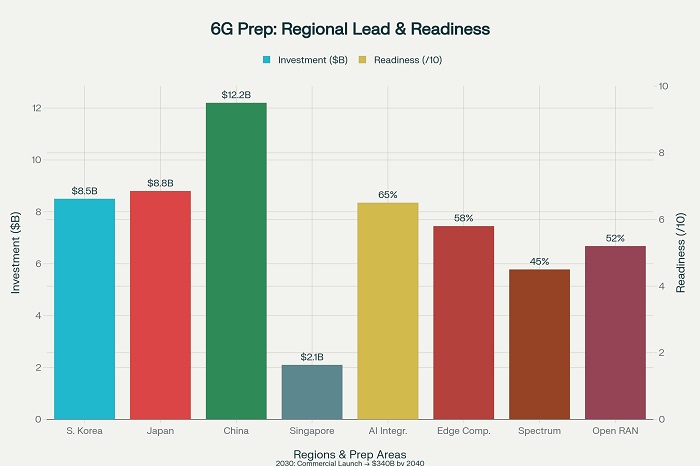Preparing for the Road to 6G
The telecommunications industry stands on the threshold of another revolutionary transformation as 6G development accelerates globally, promising exponential advancements in connectivity, artificial intelligence integration, and digital services that will reshape society by 2030. While 5G networks continue expanding across Asia and worldwide, forward-thinking operators are already positioning themselves for the next generation of wireless technology that promises near-zero latency, massive connectivity capabilities, and unprecedented integration with emerging technologies including artificial intelligence and extended reality. With the 6G market expected to be worth $340 billion by 2040, telecommunications companies must begin strategic preparation today to maintain competitive leadership in tomorrow’s digital landscape.
The 6G Vision and Timeline
6G technology development follows a structured timeline with commercial launch anticipated around 2030, giving operators a strategic window for preparation and positioning. This timeline enables comprehensive planning while allowing continued 5G investment optimization and learning integration into 6G development strategies.
Building on 5G foundations, 6G promises transformational capabilities including near-zero latency, massive IoT connectivity, integrated artificial intelligence, and support for immersive technologies that will enable new application categories and business models. These advancements will create opportunities for entirely new service offerings while transforming existing telecommunications business models.
Asia-Pacific Leadership in 6G Development
Regional Strategic Initiatives

Asia-Pacific countries are positioning themselves at the forefront of 6G standardization and development through substantial government investment and strategic industry collaboration. South Korea’s Ministry of Science and ICT launched its K-Network Strategy in 2023, pledging KRW 625 billion to ensure national leadership in 6G by 2026.
Japan’s comprehensive approach includes an 8.8-billion-euro development fund and the Beyond 5G Consortium that mobilizes public-private collaborations for next-generation connectivity leadership. This proactive investment demonstrates Asia’s ambition to shape global 6G standards while securing dominant market share in the emerging technology landscape.
China’s IMT-2030 Initiative
China’s IMT-2030 Promotion Group highlights 6G’s potential to power artificial intelligence, big data, and metaverse applications. This comprehensive vision positions 6G as the foundation for advanced digital services that will drive economic growth and technological leadership.
The Chinese approach emphasizes integration between 6G networks and emerging technologies to create comprehensive digital infrastructure platforms. This strategic positioning enables China to influence global 6G development while preparing domestic industries for next-generation connectivity advantages.
Technology Development and Innovation
Advanced Network Architecture
6G networks will incorporate artificial intelligence as a native capability rather than an add-on feature, enabling autonomous network optimization, predictive maintenance, and intelligent service delivery. This AI integration requires fundamental architectural changes that must be planned and implemented progressively.
Thailand’s successful trial of Dynamic Distributed and Deterministic Extremely Large Antenna Array with AIS demonstrates 6G cell-free concepts implementation within 5G networks. The trial achieved 7x improvement in user experience at cell edges while enabling the transition from cell-centric to user-centric service models.
Programmable and API-Driven Networks
Future 6G networks will provide extensive programmability through Application Programming Interfaces that enable third-party innovation and service development. This capability requires telecommunications operators to develop platform business models and ecosystem management capabilities.
Network APIs will become central to 6G monetization strategies by enabling external developers to create applications that leverage network capabilities. Operators must prepare for this transformation by developing API strategies and partnership frameworks that support ecosystem growth while maintaining network security and performance.
Strategic Preparation Framework
Infrastructure Evolution
Telecommunications operators should leverage current 5G deployment experience to prepare infrastructure for 6G transition. This includes implementing Open RAN architectures that provide flexibility for future technology integration while optimizing current network performance.
Edge computing deployment becomes critical for 6G readiness as future networks will require distributed processing capabilities to support ultra-low latency applications. Operators must develop edge computing strategies that position them advantageously for 6G service delivery while creating immediate 5G monetization opportunities.
Spectrum and Regulatory Preparation
6G development will require new spectrum allocations and regulatory frameworks that support advanced applications and use cases. Operators must engage actively in spectrum planning and regulatory development to ensure favorable outcomes for their market strategies.
International collaboration on 6G standardization enables operators to influence technology development while ensuring interoperability and global market access. Active participation in standards organizations becomes essential for long-term competitive positioning.
Industry Collaboration and Partnerships
Global Standardization Participation
Singapore’s establishment of the Future Communications Connectivity Lab in partnership with Singapore University of Technology and Design demonstrates the importance of research collaboration for 6G development. This initiative represents Southeast Asia’s first physical 6G research and development laboratory.
Malaysia’s participation in the 6G-SANDBOX project through Universiti Malaya enables international collaboration on next-generation network validation and demonstration. These partnerships facilitate knowledge transfer while supporting local capability development.
Private Sector Collaboration
Indosat’s AI-RAN deployment with Nokia and NVIDIA in Indonesia demonstrates how telecommunications operators can collaborate with technology providers to prepare for 6G deployment. This partnership focuses on AI-driven network efficiency and energy optimization that will become essential for 6G operations.
Singtel’s development of next-generation telecom solutions integrates artificial intelligence, network virtualization, and orchestration technologies to establish foundations for 6G adoption. This comprehensive approach demonstrates how operators can prepare systematically for next-generation network deployment.
Technology Readiness and Capability Development
Artificial Intelligence Integration
6G networks will require sophisticated artificial intelligence capabilities for network optimization, service delivery, and customer experience management. Operators must develop AI expertise and implementation capabilities that support both current network optimization and future 6G requirements.
Machine learning applications in network management, predictive maintenance, and service optimization provide immediate benefits while building capabilities required for 6G deployment. This progressive development approach enables operators to realize value from AI investment while preparing for future requirements.
Security and Resilience
6G networks will face more sophisticated cybersecurity threats that require advanced protection mechanisms and resilience strategies. Asia’s experience with increasing cyberattacks, including a 23% increase in weekly attacks per organization in 2024, demonstrates the critical importance of security preparation.
Comprehensive cybersecurity strategies must address 6G’s expanded attack surface while maintaining network performance and service quality. This requires investment in security technologies, staff training, and operational procedures that support both current and future network protection requirements.
Business Model Evolution
Platform and Ecosystem Strategies
6G deployment will enable telecommunications operators to evolve from connectivity providers to comprehensive platform operators that support diverse digital services and applications. This transformation requires new business models, partnership strategies, and revenue generation approaches.
Super app development experience in Asia provides valuable insights for 6G platform strategy development. Operators can leverage current digital service integration experience to prepare for more comprehensive platform offerings enabled by 6G capabilities.
Service Innovation Preparation
6G networks will support entirely new service categories including immersive reality applications, autonomous system control, and advanced IoT implementations. Operators must develop innovation capabilities and market understanding that position them to capitalize on these opportunities.
The transition from 5G to 6G creates opportunities for operators to establish leadership in emerging service categories while maintaining competitive advantages in traditional connectivity services. This requires balanced investment strategies that support both current operations and future growth opportunities.
Regional Market Positioning
Southeast Asian Readiness
Vietnam’s decision to phase out 2G by 2026 aligns with broader regional trends toward network modernization that supports 5G-Advanced and future 6G deployment. This infrastructure modernization creates favorable conditions for next-generation network adoption.
The Philippines’ active participation in ITU’s World Radiocommunication Conference demonstrates regional engagement in spectrum allocation and technology standardization that will influence 6G deployment conditions. This regulatory participation ensures regional representation in global 6G development.
Market Development Strategies
Despite enthusiasm for 6G development, operators must maintain focus on 5G deployment and monetization while preparing for next-generation technology. Premature 6G investment without solid 5G foundations can undermine both current and future competitive positioning.
Successful 6G preparation requires comprehensive 5G experience that provides operational insights, customer understanding, and technical capabilities essential for next-generation network deployment. This foundation enables more effective 6G strategy development and implementation.
The road to 6G represents both tremendous opportunity and significant challenge for telecommunications operators worldwide. Success requires strategic vision, substantial investment, and collaborative partnerships that position operators advantageously for the next decade of industry transformation. Companies that begin comprehensive 6G preparation today while optimizing current 5G operations will establish sustainable competitive advantages in the emerging digital economy.
The transformation to 6G will reshape telecommunications industry structure, competitive dynamics, and value creation mechanisms. Operators that embrace this change through proactive preparation, strategic investment, and collaborative innovation will thrive in the 6G era while those that delay preparation risk competitive disadvantage in rapidly evolving markets.




















